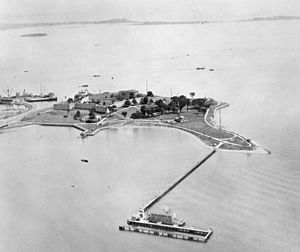Castle Island (Massachusetts) facts for kids
Quick facts for kids Castle Island |
|
|---|---|

Fort Independence at Castle Island
|
|
| Location | Boston, Suffolk, Massachusetts, United States |
| Area | 22 acres (8.9 ha) |
| Elevation | 33 ft (10 m) |
| Established | Unspecified |
| Operator | Massachusetts Department of Conservation and Recreation |
| Website | Castle Island etc. |
Castle Island is a cool spot in South Boston right on the edge of Boston Harbor. Even though it's called an island, it's actually connected to the mainland by a narrow strip of land since 1928.
This place has been important for defense since 1634. Today, it's a 22-acre park where you can relax and explore. It's also home to Fort Independence, a historic fort.
Contents
History of Castle Island
Early Forts: The 1600s
In 1632, a fort was built on Fort Hill to protect the town of Boston. But soon, people wanted stronger defenses further out in the harbor. So, in July 1634, they decided to build a fort on Castle Island.
Deputy Governor Roger Ludlow and Captain John Mason helped build this first fort. The government decided this fort was the most important to finish first. It was later known as Castle William. This fort made ships entering the harbor show respect by raising their flag, or the fort would fire at them.
After King Philip's War, the fort was used to hold captured Native Americans. Some of them were later sent away to be sold into slavery. By the end of the 1600s, the fort had grown bigger. It could even create a crossfire with another fort on Governor's Island.
Castle Island in the 1700s
In 1701, a military engineer named Colonel Wolfgang William Romer came to Boston. He helped make Castle William even stronger. By 1705, it had brick walls and 20 cannon positions. Many people were held prisoner at the fort during the 1700s.
An important event happened here in 1775. Prince Hall and fourteen other men of African descent became freemasons on the island. They joined a British Army Lodge on what was then called Castle William Island.
During the Siege of Boston in 1775-1776, Castle William was a main base for the British military. British leaders and some loyalists (people who supported the British) took shelter there. After the British left Boston on March 17, 1776, they destroyed Castle William.
After the fort was destroyed, Paul Revere was put in charge of rebuilding it. The new fort was named Fort Independence on December 7, 1797. In 1785, the fort was also used as a state prison.
The 1800s and Beyond
Starting in 1801, a new fort was built on Castle Island by the war department. This fort helped protect Boston from British attacks during the War of 1812. The island also has a monument to Donald McKay. He was famous for building speedy clipper ships like the Flying Cloud. The fort you see today was built between 1833 and 1851. It's actually the eighth fort built on this spot!
Castle Island used to be far from the shore. But over time, land was added to the mainland to make more space for port facilities. This connected the island to the mainland with paths for walking and driving. Today, the Massachusetts Department of Conservation and Recreation manages it as a state park. You can even take tours of the fort in the summer.
There's a local story that an unpopular officer was walled up in the fort's dungeon. This happened after he killed a more popular man in a duel. The famous writer Edgar Allan Poe heard this story when he was in the Army on Castle Island. His short story "The Cask of Amontillado" is said to be based on this legend.
In World War II, the U.S. Navy used the site. They had a special station there to make ships less magnetic. In 1970, Fort Independence was added to the National Register of Historic Places. This means it's recognized as an important historical site.
Visiting Castle Island
Castle Island is open to everyone all year round. The Castle Island Association works with the Massachusetts Department of Conservation and Recreation to offer fun programs.
When you visit, you can enjoy a playground, a beach for swimming, and a restaurant called Sullivan's. If you want to learn more about the fort, the Castle Island Association offers tours of Fort Independence during certain seasons.






